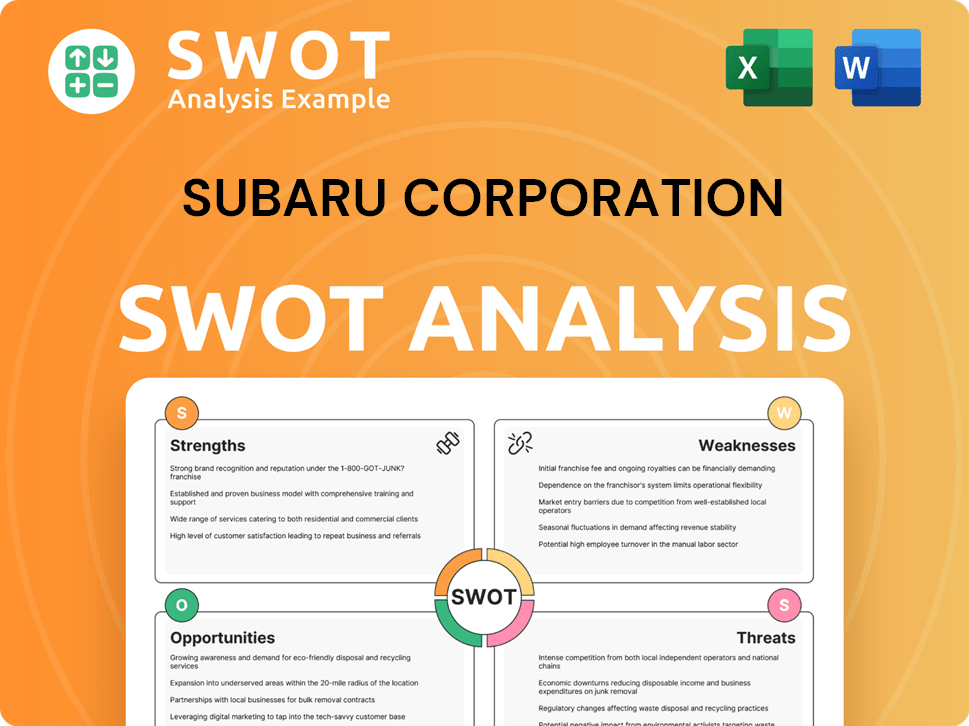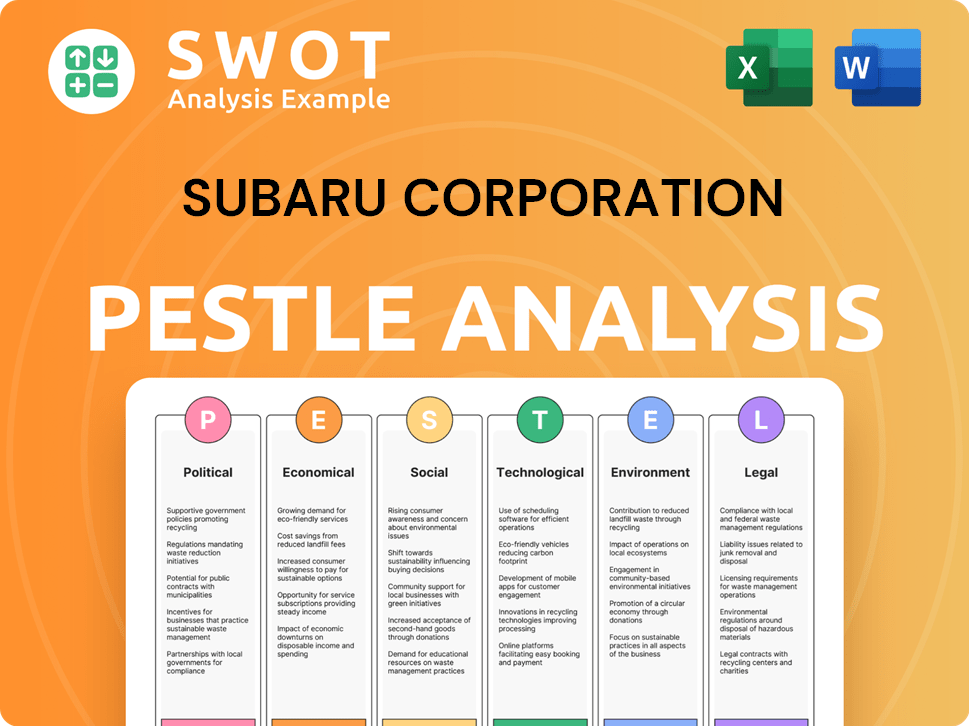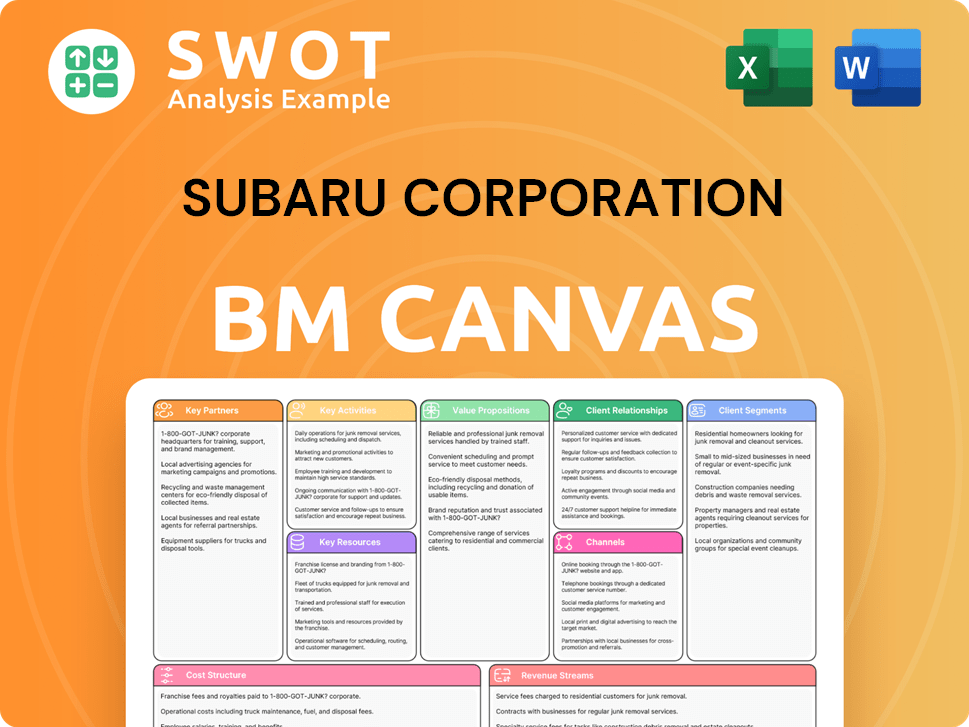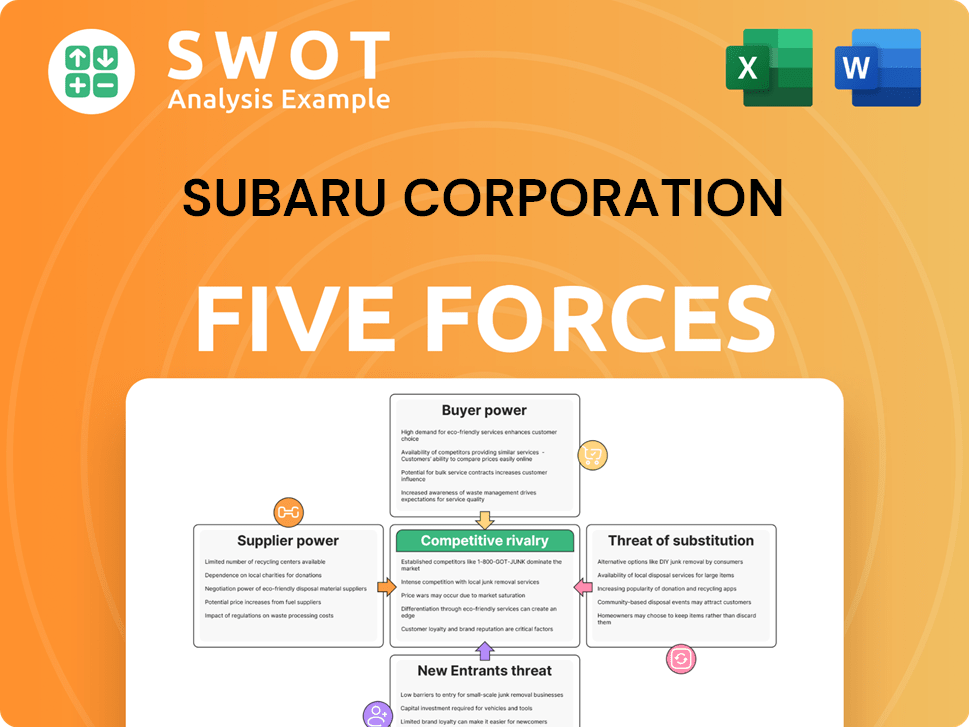Subaru Corporation Bundle
How Does Subaru Corporation Stack Up Against Its Rivals?
Subaru, known for its distinctive boxer engines and all-wheel-drive systems, has cultivated a loyal following in the automotive world. With a history rooted in aircraft manufacturing, the company has evolved into a significant player in the global market. This analysis dives deep into the Subaru Corporation SWOT Analysis and its competitive arena.

Understanding the Subaru competitive landscape is crucial for investors and industry observers alike. This exploration provides a detailed Subaru market analysis, identifying key Subaru competitors and evaluating their strengths relative to Subaru's. We'll dissect the automotive industry dynamics, examining car manufacturers and their strategies to provide actionable insights into Subaru's position and future prospects, including its Subaru's global market share analysis and Subaru's SUV market competition.
Where Does Subaru Corporation’ Stand in the Current Market?
Subaru holds a distinctive market position within the automotive industry, particularly in the United States and Canada. The company's focus on customer satisfaction, safety, and reliability has cultivated a loyal customer base. This strong brand reputation is a key factor in its competitive landscape.
Subaru's core operations are centered around the design, manufacturing, and sale of automobiles, with a significant emphasis on SUVs. The company's value proposition revolves around providing vehicles that offer a blend of safety, dependability, and all-weather capability, appealing to a specific segment of the market. This focus has allowed it to carve out a niche within the broader automotive industry.
In the 2024 American Customer Satisfaction Index (ACSI) Survey, Subaru of America achieved the top ranking in the automobile industry, with an ACSI score of 83. This underscores its commitment to customer satisfaction. Furthermore, Subaru was rated #1 in customer loyalty, dependability, and safety among mass-market automotive companies in the 2024 ACSI surveys.
Subaru's strong performance in customer satisfaction surveys highlights its success in building brand loyalty. This is crucial in the competitive automotive industry. The company's focus on quality and reliability contributes to its high customer retention rates.
Subaru's SUV models, such as the Crosstrek, Forester, and Outback, are key drivers of its sales. The U.S. market is its largest, accounting for a significant portion of its global sales. Strong sales figures demonstrate the company's ability to compete effectively.
The United States is Subaru's most important market, representing a substantial portion of its consolidated sales. The company also sees significant growth in Canada. These key markets are vital for Subaru's overall financial health.
Subaru reported a substantial increase in consolidated revenue for the fiscal year ended March 31, 2024. While the company anticipates a decrease in operating profit for the fiscal year ending March 31, 2025, it remains financially robust. For more details on the company's strategic direction, see Growth Strategy of Subaru Corporation.
Subaru's market position is supported by strong sales figures and customer loyalty. The company's focus on SUVs and its performance in key markets contribute to its overall success within the automotive industry. Understanding these metrics is crucial for assessing the Subaru competitive landscape.
- In the U.S., retail sales increased for 26 consecutive months through September 2024.
- In Canada, Subaru achieved record sales of 68,043 units in 2024, a 23.8% year-over-year increase.
- The Crosstrek was the top-selling model in the U.S. in 2024, with 181,811 units sold.
- Subaru's consolidated revenue for the fiscal year ended March 31, 2024, was 4,702.9 billion yen.
Subaru Corporation SWOT Analysis
- Complete SWOT Breakdown
- Fully Customizable
- Editable in Excel & Word
- Professional Formatting
- Investor-Ready Format

Who Are the Main Competitors Challenging Subaru Corporation?
The automotive market is intensely competitive, and Subaru Corporation faces significant challenges from a wide array of global automakers. Understanding the Subaru competitive landscape is crucial for assessing its position and future prospects. The company's success depends on its ability to differentiate itself in a crowded market and respond effectively to the strategies of its rivals.
Subaru's main rivals include major Japanese, South Korean, American, and European car manufacturers. These competitors challenge Subaru across various fronts, including product offerings, pricing, technological advancements, and marketing strategies. Analyzing these factors helps in understanding the competitive dynamics and potential areas of growth or vulnerability for Subaru.
The Subaru market analysis reveals a complex web of competition, with each player vying for market share. The automotive industry is constantly evolving, with new players and technologies emerging. This dynamic environment requires Subaru to continually adapt and innovate to maintain its competitive edge.
Subaru's direct competitors include Toyota, Honda, Nissan, Hyundai, Kia, Ford, General Motors, Volkswagen, and Mazda. These companies compete with Subaru in various segments, including SUVs, sedans, and electric vehicles. Each competitor brings unique strengths and strategies to the market.
In the compact SUV segment, the 2025 Subaru Forester faces competition from the Toyota RAV4, Honda CR-V, Mazda CX-5, Ford Escape, and Nissan Rogue. These models are popular choices for consumers, and Subaru must differentiate itself through features, pricing, and brand reputation.
The 2025 Subaru Outback competes with the Toyota RAV4, Honda CR-V, Ford Bronco Sport, Nissan Rogue, Hyundai Tucson, Mazda CX-50, and Volkswagen Tiguan. This segment is crucial for Subaru, as it offers a balance of space, features, and affordability.
The 2025 Subaru Crosstrek competes with the Volkswagen Taos and Mazda CX-30. This segment is growing in popularity, and Subaru must offer competitive pricing and features to attract buyers.
Toyota and Honda leverage extensive model lineups, strong brand recognition, and investments in hybrid and electric vehicle technologies. Ford and General Motors offer a broad range of vehicles, including popular trucks and SUVs. Hyundai and Kia have gained market share through competitive pricing, attractive designs, and improved warranties.
The increasing demand for electric vehicles (EVs) is a significant factor, with many established automakers and new EV startups vying for market share. Subaru's partnership with Toyota for EV development is becoming increasingly important.
Analyzing Subaru's competitors reveals diverse strategies and strengths. Toyota and Honda excel in reliability and fuel efficiency, while Ford and General Motors dominate the truck and SUV markets. Hyundai and Kia offer value through competitive pricing and warranties. Understanding these competitive advantages is crucial for Subaru's strategic planning.
- Toyota: Known for reliability and hybrid technology. In 2024, Toyota's global sales reached approximately 9.4 million vehicles.
- Honda: Strong in fuel efficiency and brand reputation. Honda's global sales in 2024 were around 4.1 million vehicles.
- Nissan: Offers a range of vehicles with a focus on value. Nissan's global sales in 2024 were approximately 3.4 million vehicles.
- Hyundai/Kia: Gaining market share through competitive pricing and design. Combined sales in 2024 exceeded 7 million vehicles globally.
- Ford: Strong in trucks and SUVs, particularly in the North American market. Ford's 2024 sales in North America were roughly 1.9 million vehicles.
- General Motors: Another major player in the North American market, with a focus on trucks and SUVs. GM's 2024 sales in North America were approximately 2.6 million vehicles.
- Volkswagen: A major European automaker with a global presence. Volkswagen's global sales in 2024 were around 4.8 million vehicles.
- Mazda: Known for its focus on driving dynamics and design. Mazda's global sales in 2024 were approximately 1.2 million vehicles.
Subaru Corporation PESTLE Analysis
- Covers All 6 PESTLE Categories
- No Research Needed – Save Hours of Work
- Built by Experts, Trusted by Consultants
- Instant Download, Ready to Use
- 100% Editable, Fully Customizable

What Gives Subaru Corporation a Competitive Edge Over Its Rivals?
Understanding the Target Market of Subaru Corporation is crucial to analyzing its competitive advantages within the automotive industry. Subaru's success is built on a foundation of engineering excellence, a strong brand identity, and unwavering customer loyalty. This combination allows Subaru to stand out in a crowded market, appealing to a specific customer base that values safety, reliability, and a sense of adventure.
Subaru's competitive advantages are multifaceted, stemming from its unique engineering, commitment to safety, and strong brand reputation. Its distinctive features, such as the boxer engine and standard Symmetrical All-Wheel Drive (AWD), set it apart from many competitors. Furthermore, Subaru's focus on safety and customer satisfaction has cultivated a loyal customer base, contributing significantly to its market position.
The company's strategic moves, including collaborations and niche market targeting, further solidify its competitive edge. These advantages have evolved over time, with Subaru consistently refining its core technologies and adapting its marketing to emphasize safety, reliability, and adventure. However, the automotive industry's rapid shifts, particularly towards electrification, present ongoing challenges to maintain this differentiation.
Subaru's use of the horizontally opposed 'boxer' engine in most vehicles provides a lower center of gravity, enhancing handling and stability. The standard Symmetrical All-Wheel Drive (AWD) system offers superior traction and control, especially in challenging conditions. These features are key differentiators in the
Subaru consistently earns top safety ratings from organizations like NHTSA and IIHS. In the 2024 American Customer Satisfaction Index Survey, Subaru was rated the #1 brand for vehicle safety for five consecutive years. The EyeSight® Driver Assist Technology, standard on many models, further enhances safety, making Subaru a leader in the
Subaru is known for reliability, durability, and longevity. In 2024, Consumer Reports named Subaru the most reliable brand, achieving 68/100 points. This strong reputation translates into exceptional customer loyalty. Subaru has been rated #1 in customer loyalty among mass-market automotive companies in the 2024 ACSI surveys, a key factor in
Subaru targets customers with diverse lifestyles and higher purchasing power. The company leverages strategic partnerships, such as its collaboration with Toyota on hybrid and electric vehicle development, to expand its product offerings. This focus allows it to cater to specific customer preferences and build strong relationships, influencing
Subaru's competitive advantages are deeply rooted in its engineering, safety features, and brand reputation. These elements collectively contribute to its strong market position and customer loyalty. Understanding these advantages is crucial for analyzing
- Boxer Engine and Symmetrical AWD: Provides superior handling and control.
- Safety Ratings: Consistently high ratings from NHTSA and IIHS.
- Reliability and Durability: Strong reputation and high scores in reliability surveys.
- Customer Loyalty: Ranked #1 in customer loyalty among mass-market automotive companies in 2024.
- Strategic Partnerships: Collaborations like the one with Toyota for hybrid and EV development.
Subaru Corporation Business Model Canvas
- Complete 9-Block Business Model Canvas
- Effortlessly Communicate Your Business Strategy
- Investor-Ready BMC Format
- 100% Editable and Customizable
- Clear and Structured Layout

What Industry Trends Are Reshaping Subaru Corporation’s Competitive Landscape?
The automotive industry is in a state of significant transformation, driven by technological advancements, shifting consumer preferences, and global economic changes. This creates both challenges and opportunities for car manufacturers like Subaru Corporation. The transition to electric vehicles (EVs), the rise of software-defined vehicles, and increased competition, especially from innovative manufacturers, are key trends shaping the industry. Understanding the Subaru competitive landscape is crucial to assess its position and future prospects.
Subaru faces the challenge of adapting to these trends while competing with established players and new entrants. The company's ability to navigate the shift to electrification, manage geopolitical trade tensions, and continue to deliver vehicles that resonate with its loyal customer base will be critical. A thorough Subaru market analysis is essential to evaluate its strategic position and potential for growth.
The automotive industry is undergoing a rapid transition to electric vehicles (EVs), with increasing demand and technological advancements. The rise of software-defined vehicles is changing how cars are designed, manufactured, and sold. Competition is intensifying, particularly from innovative manufacturers, including those from China, creating a dynamic market environment. These trends are significantly impacting Subaru Corporation.
One of the main challenges for Subaru is the slowdown in EV adoption in some markets and the growing competition in the EV segment. Regulatory changes and geopolitical dynamics, such as tariffs and emission regulations, also pose a significant challenge. Managing supply chain disruptions and ensuring production capacity to meet demand are additional hurdles. These challenges require strategic adaptation to maintain competitiveness.
The growing global demand for EVs offers a long-term opportunity for Subaru to expand its market share by developing and offering more EV models. Leveraging collaborations and partnerships, particularly with companies like Toyota, will be crucial for accessing new technologies and accelerating EV development. Expanding its global market share beyond its strong presence in the U.S. presents further growth potential.
Subaru's strong brand loyalty, reputation for safety, and all-wheel-drive expertise can serve as foundations for its future strategies. Investing in new technologies, adapting to changing consumer preferences, and effectively navigating the shift to electrification are crucial. Focusing on its core strengths while innovating will be key to remaining competitive in the automotive industry.
The Subaru competitive landscape is evolving rapidly, with significant shifts in the automotive industry. The company must address challenges such as the slowdown in EV adoption and manage geopolitical risks. Opportunities lie in expanding its EV offerings and leveraging collaborations.
- EV Market Dynamics: Subaru's Solterra saw a 34.8% monthly sales drop in April 2025, highlighting the need for accelerated EV development.
- Geopolitical Impact: A 25% U.S. tariff on imported vehicles and parts has led to a projected 4% sales decline for Subaru in 2025-2026.
- Production Strategy: Subaru aims to boost its Indiana plant output to 500,000 vehicles annually by 2027 to mitigate tariff impacts.
- Competitive Positioning: The company's success depends on effectively navigating electrification and maintaining customer loyalty.
Subaru Corporation Porter's Five Forces Analysis
- Covers All 5 Competitive Forces in Detail
- Structured for Consultants, Students, and Founders
- 100% Editable in Microsoft Word & Excel
- Instant Digital Download – Use Immediately
- Compatible with Mac & PC – Fully Unlocked

Related Blogs
- What are Mission Vision & Core Values of Subaru Corporation Company?
- What is Growth Strategy and Future Prospects of Subaru Corporation Company?
- How Does Subaru Corporation Company Work?
- What is Sales and Marketing Strategy of Subaru Corporation Company?
- What is Brief History of Subaru Corporation Company?
- Who Owns Subaru Corporation Company?
- What is Customer Demographics and Target Market of Subaru Corporation Company?
Disclaimer
All information, articles, and product details provided on this website are for general informational and educational purposes only. We do not claim any ownership over, nor do we intend to infringe upon, any trademarks, copyrights, logos, brand names, or other intellectual property mentioned or depicted on this site. Such intellectual property remains the property of its respective owners, and any references here are made solely for identification or informational purposes, without implying any affiliation, endorsement, or partnership.
We make no representations or warranties, express or implied, regarding the accuracy, completeness, or suitability of any content or products presented. Nothing on this website should be construed as legal, tax, investment, financial, medical, or other professional advice. In addition, no part of this site—including articles or product references—constitutes a solicitation, recommendation, endorsement, advertisement, or offer to buy or sell any securities, franchises, or other financial instruments, particularly in jurisdictions where such activity would be unlawful.
All content is of a general nature and may not address the specific circumstances of any individual or entity. It is not a substitute for professional advice or services. Any actions you take based on the information provided here are strictly at your own risk. You accept full responsibility for any decisions or outcomes arising from your use of this website and agree to release us from any liability in connection with your use of, or reliance upon, the content or products found herein.